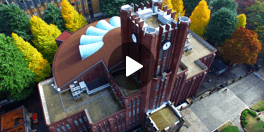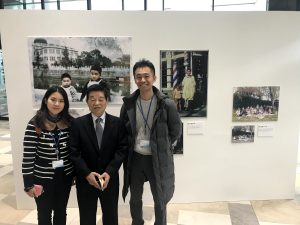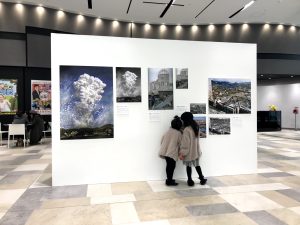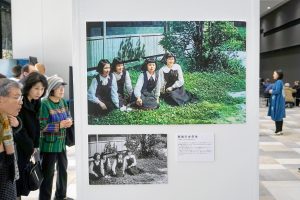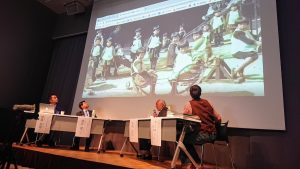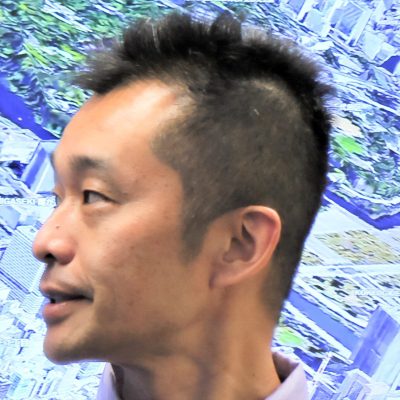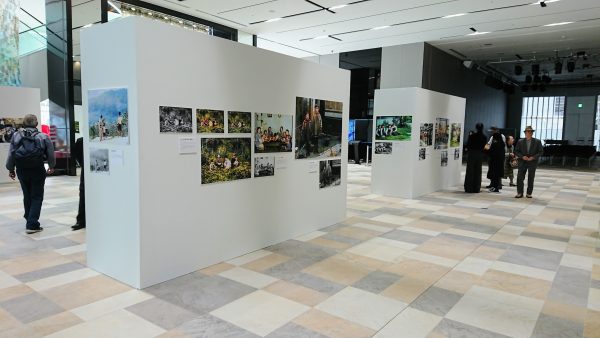
January 22, 2019
広島テレビ 新社屋「 記憶の解凍 」展覧会“Rebooting Memories” Exhibition at Hiroshima Television Building
2018年11月23日〜12月2日、広島テレビ新社屋にて「記憶の解凍〜カラー化写真で時を刻み、息づきはじめるヒロシマ〜」展(広島テレビ放送および、渡邉英徳研究室主催)を開催しました。
私たちはこの約一年、広島における「記憶の解凍」プロジェクトを進めてきました。「記憶の解凍」とは、人工知能技術(1)で自動カラー化した写真をもとにして、対話の場を生み出す試みです(2)。過去の資料の「凍りついた」イメージが、最新技術で「解凍」され、コミュニケーションが創発されることによって、過去の記憶が未来に継承されます。
今回の展覧会は、その集大成となりました。
このプロジェクトは、一人の高校生と私たちの出会いから始まりました。広島女学院高等学校の庭田杏珠さんは、学校の署名実行委員会に所属しており、渡邉英徳研究室の「ヒロシマ・アーカイブ」の活動にも参加するなど、平和活動に積極的に取り組んできました。そんな庭田さんに自動カラー化の技術を教えたことが、このプロジェクトの発端です。
庭田さんは、現在は広島平和記念公園となっている「旧・中島地区」に着目しました。かつてそこにお住まいで、原爆投下によりすべての家族をうしなった濱井德三さんとの交歓と、カラー化技術が、庭田さんのなかで結びつきました。
いまは公園となった場所は、かつて4400人が暮らした繁華街だったこと。そこにあった平和な暮らしが、一発の原子爆弾によって永遠に失われてしまったこと。こうした事実から、平和の大切さを多くの人に感じてもらいたい。
広島で生まれた若者の、このまっすぐなコンセプトが源流となり、次第に多くの人々のちからが集まり、この展覧会が実現しました。会期中には、3500人以上の市民が会場を訪れました。この記事と同様のカラー化ワークショップや、シンポジウムも開催しました。会場中央に据えられたテーブルでは、被爆者と市民の,あたたかな語らいの場が生まれていました。
なお、庭田さんと山浦徹也君(首都大学東京大学院)による、同タイトルの映像作品は「国際平和映像祭2018」にて学生部門賞を受賞。11月にはニューヨークにて招待上映・スピーチを行ないました。その後、パリ・ユネスコ本部で開催された「記憶と災害についての国際フォーラム」では、私と庭田さんが連名で招待プレゼンテーションを行なっています。
若者の純粋な思いと、小さいけれど、大切な活動。それが、多くの人々のちからに支えられながら世界に届いたことは、私たちの記憶に強く刻まれていくはずです。
記事:渡邉英徳(教授)
(1) Satoshi Iizuka, Edgar Simo-Serra, Hiroshi Ishikawa: “Let there be Color!: Joint End-to-end Learning of Global and Local Image Priors for Automatic Image Colorization with Simultaneous Classification.”; ACM Transaction on Graphics (Proc. of SIGGRAPH), Vol. 35, No. 4, #110, 2016.
(2) 「記憶の解凍」 資料の“フロー” 化とコミュニケーションの創発による記憶の継承(デジタルアーカイブベーシックス第2巻 草稿)
We held an exhibition titled “Rebooting Memories: Hiroshima’s time advancing and breathing through colorized photographs” at Hiroshima Television Building from November 23rd to December 2nd, 2018 (hosted by Hiroshima Television Corporation and Hidenori Watanave Lab).
For about a year, we have been promoting the “Rebooting Memories” project in Hiroshima. “Rebooting Memories” is an activity that creates places of dialogue based on photographs automatically colorized by an artificial intelligence technology(1). This increases the information value by converting records “stocked” in society into “flowing” images, thus transmitting past memories to the future based on emerging communication.
This exhibition was a compilation of our achievements so far.
Our project began with an encounter with a high school student. Ms. Anju Niwata at Hiroshima Jogakuin Senior High School belongs to the school’s signature collecting committee and participates in the activities of our laboratory’s “Hiroshima Archive“. She is very enthusiastic about peace activities. About a year ago, I taught her the technique of automatic coloring. This was the beginning of everything.
Ms. Niwata focused on the “former Nakajima District” before the atomic bombing which is now the Hiroshima Peace Memorial Park. She has interacted with Mr. Tokusho Hamai who once lived in the district and lost all his family as a result of the atomic bomb. She linked her empathy with Mr. Hamai with the technique of automatic colorization.
The district that has now become a park was once a downtown area inhabited by 4,400 people. Peaceful lives there were lost forever as a result of the atomic bomb. She wanted many people to feel the importance of peace through these facts.
The exhibition was realized with the help of many people, based on this simple concept originating from a high school student born in Hiroshima. During the exhibition, more than 3,500 citizens visited the hall. We also held a colorization workshop and a symposium at the venue. There was a place for a friendly conversation between atomic bomb survivors and citizens, sitting at a table set in the center of the hall.
Additionally, a film work of the same title by Ms. Niwata and Mr. Tetsuya Yamaura (Graduate School of Tokyo Metropolitan University) received the Student Division Award at “UNITED FOR PEACE FILM FESTIVAL (UFPFF) 2018” and they were invited to United Nations Headquarters (NY) for a screening and a speech in November. Ms. Niwata and I were also invited to make a presentation of our project at a global policy forum on disaster risk reduction for preserving documentary heritage held by UNESCO Headquarters (Paris) in December.
The sincere ideas of young people and small but valuable activities were helped by many people and delivered to the world. We will not forget what happened in the past year in Hiroshima.
Text: Hidenori Watanave (Professor)
Proofreading: David Buist (Project Senior Specialist)
(1) Satoshi Iizuka, Edgar Simo-Serra, Hiroshi Ishikawa: “Let there be Color!: Joint End-to-end Learning of Global and Local Image Priors for Automatic Image Colorization with Simultaneous Classification.”; ACM Transaction on Graphics (Proc. of SIGGRAPH), Vol. 35, No. 4, #110, 2016.
主担当教員Associated Faculty Members
教授
渡邉 英徳
- 文化・人間情報学コース
- 先端表現情報学コース
- アジア情報社会コース
- 情報学環教育部
Professor
WATANAVE, Hidenori
- Cultural and human information studies course
- Emerging design and informatics course
- ITASIA program
- Undergraduate research student program

